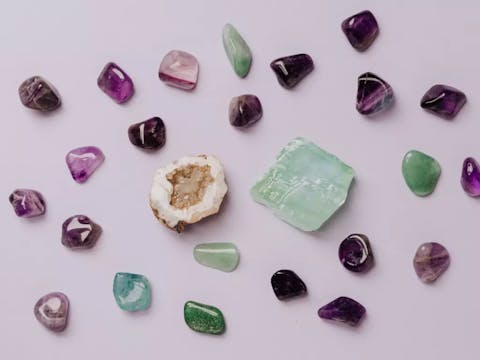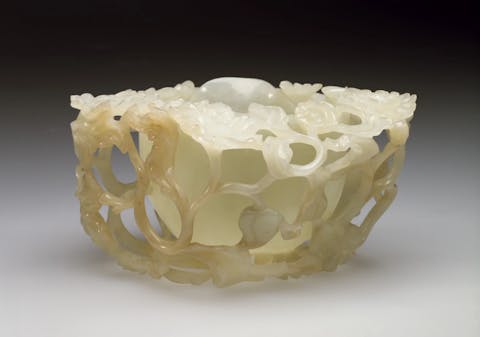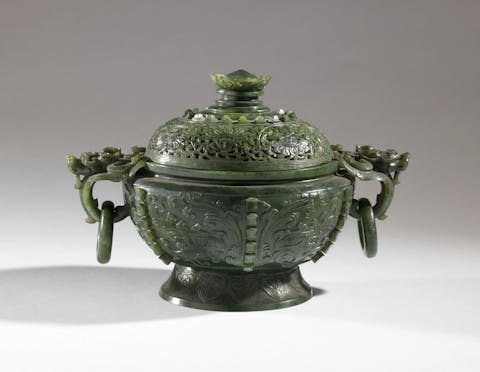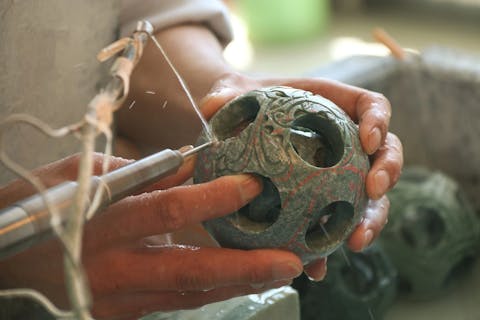The meaning of Jade
For thousands of years, jade stone has been coveted by many as a symbol of wealth, status, and ritual.
Diamond and Jade necklace. Image via Pixbay
With its vivid color and brilliant luster, it is effortlessly timeless and elegant; people across the world today still associate it with beauty, luxury, and royalty, as has been done for generations. It is easy to understand why the semi-precious stone is so highly valued amongst audiences today, as not only is it a gorgeous piece of nature that can be the center of a piece of jewelry or decoration, but there is also a mysterious quality associated with the appearance of its pure and colorful surface, as if by holding a piece of jade, one holds within their hands a tiny piece of the universe itself.
What is jade stone?
The word jade can in fact refer to two different minerals, as was discovered in 1863 by French mineralogist Alexis Damour, which are known as jadeite and nephrite. Nephrite consists of a fibrous matrix of calcium, while jadeite, the more highly valued of the two, is comprised of an interlocking growth of crystals. Jadeite is harder and much rarer, only being found in 12 places throughout the entire world.

Jade stones in various colors. Image via Canva
Colors of jade and its value
Nephrite most often occurs in light green and creamy white variations, while jadeite occurs in a great multitude of colors such as pink, blue, brown, red, dark green, lavender, white, and black. The most highly prized variation today and throughout history is a translucent emerald green jadeite known as Imperial Jade, which at one time was reserved only for the Emperor of China due to its rarity. The most expensive piece of jade jewellery ever sold was the necklace of 27 imperial jadeite beads and a ruby and diamond clasp made by Cartier's jewellers for American heiress, Barbara Hutton. The so called Hutton-Mdivani jade necklace was sold to Cartier's Collection during a Sotheby's auction in Hong Kong in 2014 for a record-breaking $27.44 million.
The use of jade stone
Thousands of years ago during Neolithic times, it was valued for its toughness as it was able to serve as axeheads, weapons, and tools for scraping and hammering. In Ancient China over 5000 years ago, artisans began using jade to produce decorative and ritualistic objects. Royal members of the Han Dynasty were buried in jade burial suits made of thin jade plaques, connected with golden wire. Those suits were seen as a display of wealth and a social status and were often more expensive than silver or gold. Jade was a popular material to use for calligraphy brush stands, and opium pipe mouth pieces; at that time it was believed that breathing through jade would bestow longevity upon the smoker. Jade became an emblematic material of the Chinese Empire, and still today is highly associated with their history and development of traditional artwork.
Related: A brief History of Chinese Art

Brushwasher in the Form of a Peony, China, 16th- 17th century, William T. / Henry Walters Collection, Baltimore, Walters Art Museum, 1931
"...serious collectors and buyers on today’s market tend to steer clear of such interferences, and enjoy the stone simply for its natural beauty."
Raw jade stone or treated?
As the hue and consistency of color plays such a crucial role in deciding the price of jade, artisans throughout time have found different ways to improve its appearance. It is possible to use a variety of tactics to alter the color, luster, and stability of the stone, including wax, heat, bleach, dye, acid, polymer injection, and more. In some cases, these processes may have long been used by traditional jade workers, but serious collectors and buyers on today’s market tend to steer clear of such interferences, and enjoy the raw jade simply for its natural beauty.
Related: How to value Jade

Perfume Bowl carved in Jade, China, 18th century, Paris Musées / Petit Palais, musée des Beaux-Arts de la Ville de Paris
Treated jade can be categorized into type A, B, and C. Type A jade has simply been treated with a layer of wax to improve the sheen of the surfaces. This kind of treatment is widely accepted on the market and will not affect its overall value. Type B jade has been soaked in acid and bleached in order to remove oxidization stains and sodium deposits. It is then impregnated with wax in order to improve its overall appearance, however the quality of the jade will eventually deteriorate. Type C jade receives the same bleaching and wax impregnation treatments but in addition has also been dyed. As Type B and C adversely affect the lifespan of quality for a jade piece, they are typically not as highly valued as their natural counterparts.

The process of carving Jade Stone. Image via pixbay
The Imperial Stone
There is no doubt that jade is among one of the most eye catchingly breathtaking pieces of naturally occurring art. It is no wonder that so many buyers today are drawn in by its brilliant luster and depth of color in any variety. From its early uses as tools and weapons to its quick rise towards the exclusive status of royalty, it has been highly prized by people since its beginning and will likely continue to be sought after by appreciators of luxury for thousands of more years to come.

